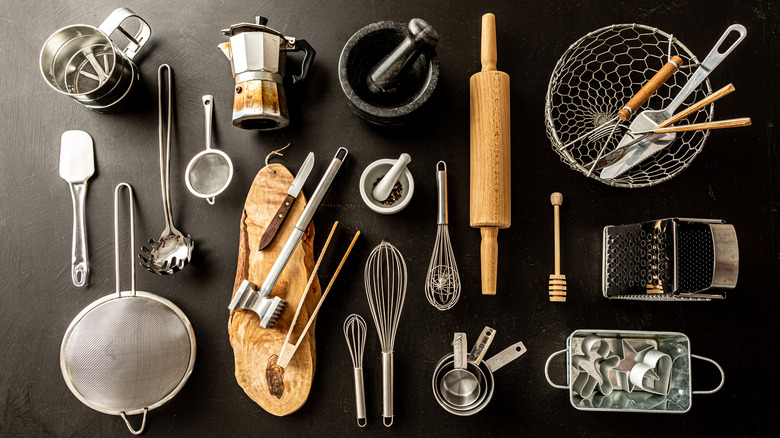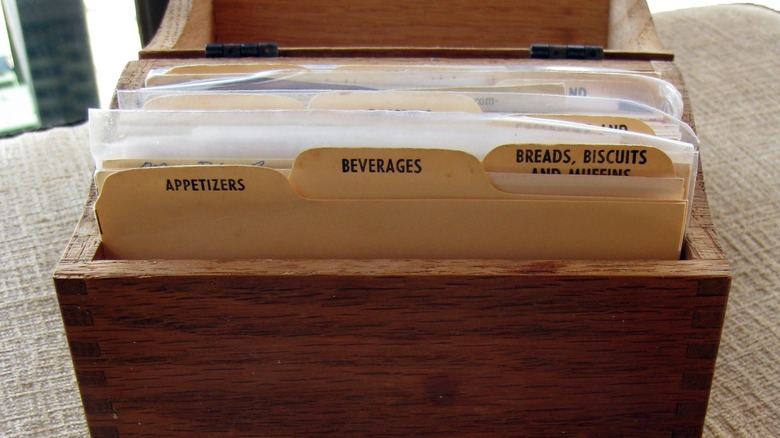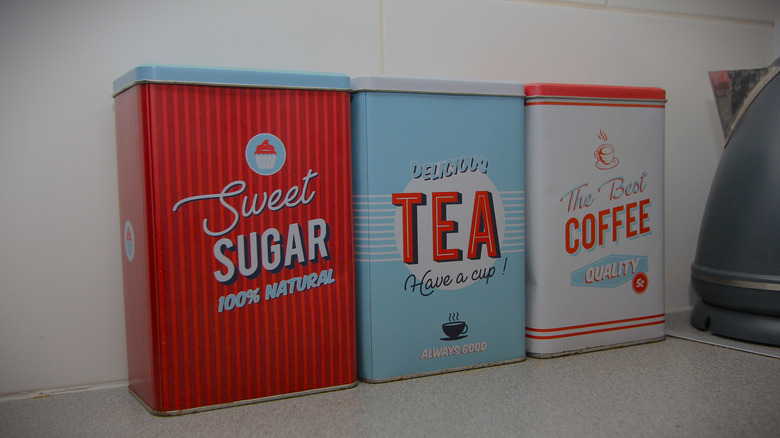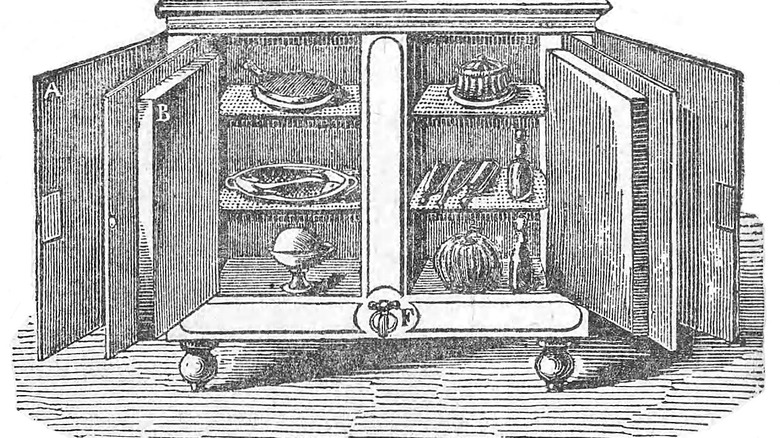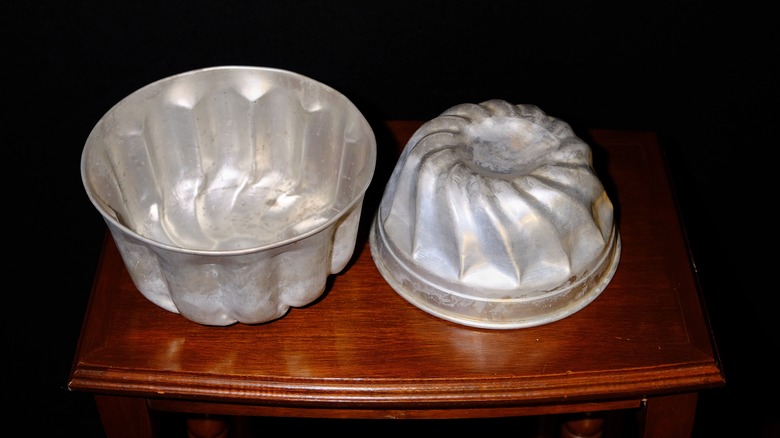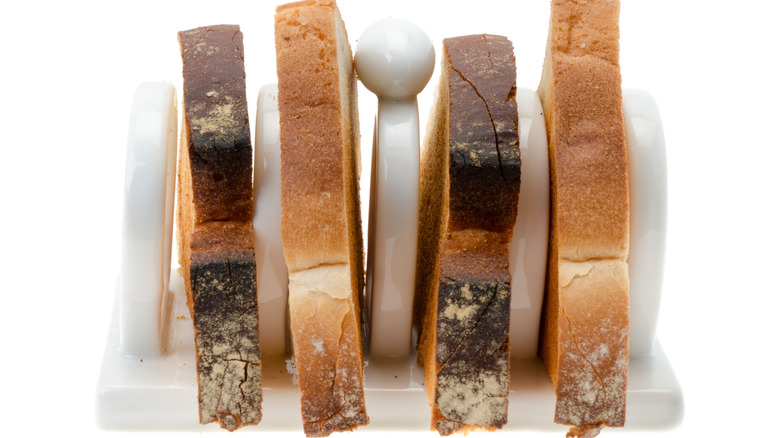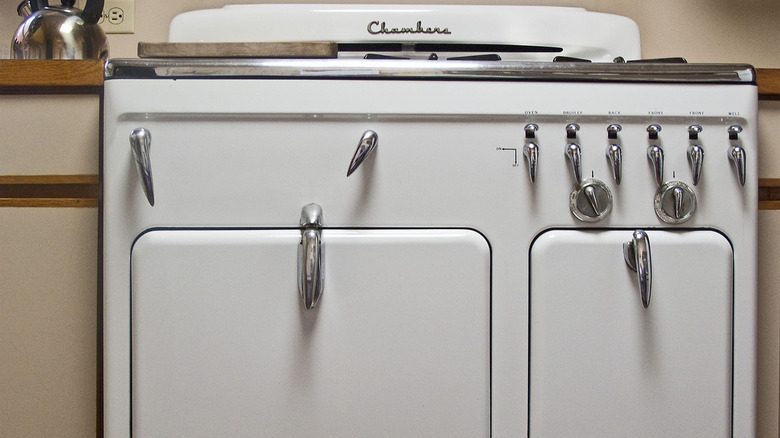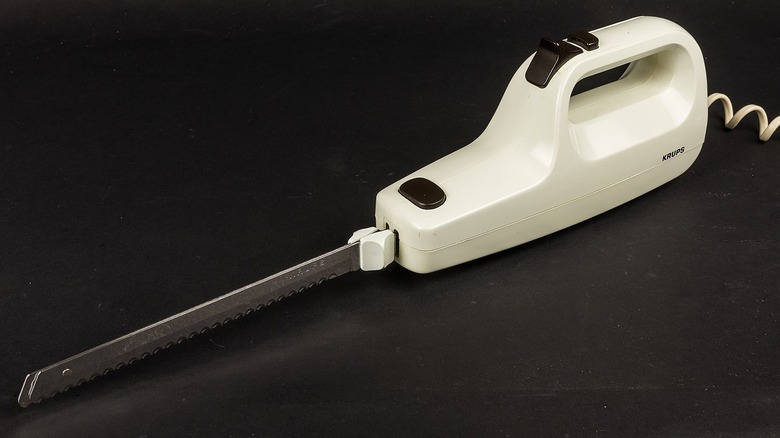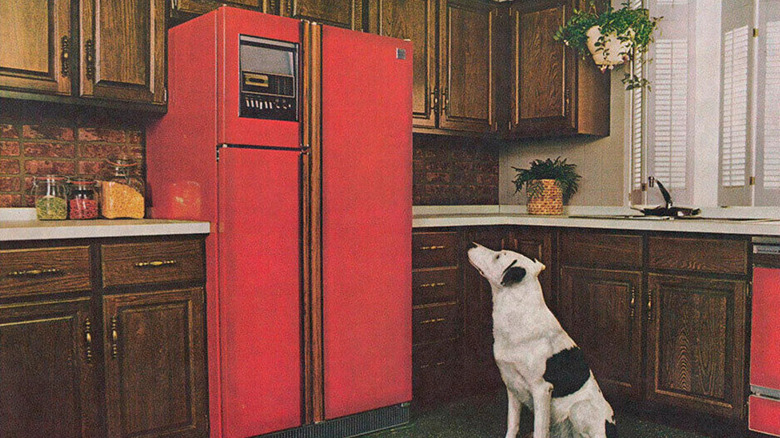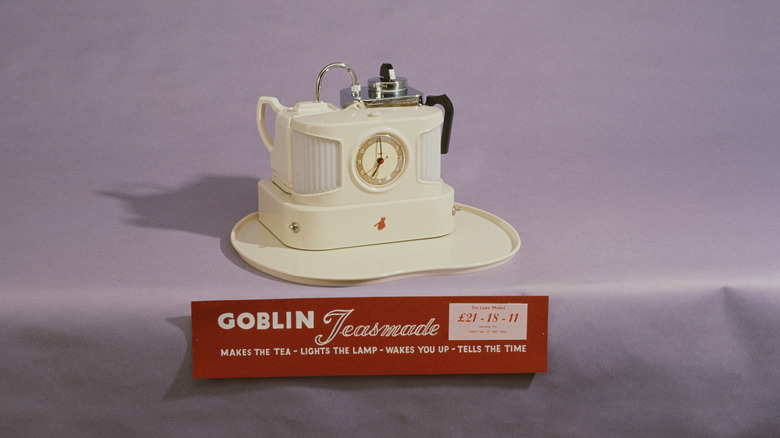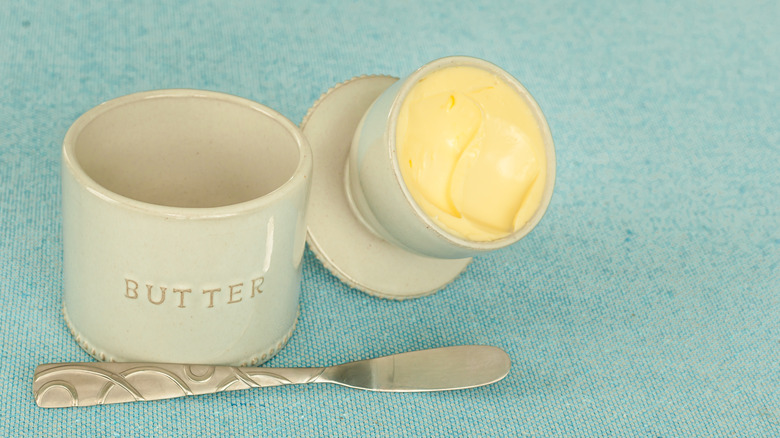Once Popular Vintage Kitchen Tools That No One Uses Anymore
Human history can be traced by the evolution of cooking technology. Food is a daily necessity for all of us, and necessity is after all the mother of invention. Tastes and needs change over time but the human knack for tinkering has not diminished. Whether considering aesthetic appeal, kitchen safety, ease of use, or cost efficiency, there are always ways to make products better and more appealing. Tools from the invention of fire itself to the Wi-Fi-enabled oven, history is littered with groundbreaking innovations that eventually go by the popular wayside.
The turn of the 20th century sparked a new revolution in kitchenware consumerism. As electricity became a widespread utility and America's economy boomed, backyard inventors and tech companies sought to make cooking faster, easier, and cheaper — sometimes sexier, too. A cook who grew up with a dinner bell and an icebox would've lived to see the electric knife and induction stove.
Better does not always mean best, however, and some classic kitchen appliances continue to resurface on the internet and on our counters. Some of these gadgets are so intuitive that you might wonder why they were ever replaced. Some outlived their function because of their tasteful antiquarian form. Some are prized work horses sought after because they simply don't make 'em like they used to. A few are too dangerous or too clever for their own good. Here are a few once popular kitchen appliances that for better or worse, don't stock our shelves and kitchen today.
Manual grocery shopping list
This vintage kitchenware piece resurfaces from time to time on the internet, and even in the app era, it has aged quite practically. The conceit is you keep it in your kitchen and tick off the arrow whenever you run out of a staple food. Then, you take it to the grocery store with you and flick the arrows back as you re-stock.
The Gen Z and millennial default is creating your grocery list in the notes app. iPhones even have an option to create a checklist. However, some of us, this author included, have a million unlabeled notes on our phone that are impossible to sift through. Having a dedicated physical tool that stays in one place in your kitchen has obvious upside. Plus, there's no social media on this vintage grocery list to distract you when you write down your necessities.
The real winner here is that you never have to wonder what you're out of since you make note of your essentials as you run out of them. If you don't buy basics on every weekly trip to the grocery store, you may not be in the habit of checking your stock before every trip. This is a handy way to remember plain but important ingredients like salt, butter, and flour. Plus, the metal's patina is quite beautiful and makes for an adorable period piece to hang in your kitchen.
Recipe box
Speaking again from the luddite soapbox, recipe boxes are another simple appliance that the internet age has over-engineered. Amazon Alexa is handy but it's basically a recipe box that play music and eavesdrop on your conversations.
There's nothing wrong with using the internet, but when it's time to make dinner after a long day of work, would you rather pull out an old reliable or sift through the thousands of recipes and their thousands of variations on the internet. The internet is a fantastic resource, but picking a recipe can be as difficult as choosing what to watch on Netflix. Plus, we can all relate to the frustration of scanning through long personal diatribes to find the recipe and ingredients list in online recipes.
This might be a simple solution if you're constantly asking your mom to send you her chili recipe, or if you can't remember if the recipe is in the cloud, your phone, or a notebook. Sometimes it's best to keep it simple and play the hits. Recipe boxes can literally just be a box that you keep in your fridge. If that sounds like too much work Alexa can do the remembering for you.
Metal storage tins and tools
"One word: plastics, there's a great future in plastics," Mr. McGuire tells Dustin Hoffman at his debutant party in the film "The Graduate." Mr. McGuire, played by Walter Brooke, was dead on. The second half of the 21st century could be called the rise of the planet of the plastics. Prior to that, food storage was mostly metal. That's why another word for storage is the "tin." Plastic production ramped up in the 1950s and the rise of Tupperware made it a dominant in all facets of our lives, especially in the grocery store, food storage, and appliances.
Although plastic doesn't grow on trees, it can be easily synthesized. That makes it cheap to mass produce and consumers reap the savings. These days plastic is ubiquitous, and metal is typically used where plastic will melt or in high end products. As we all become more conscious of waste and our impact on climate change as individuals, metal containers could make a comeback. Some metal appliances have a long use life that outlives the original owner, whereas plastic appliances are synonymous with turnover. Yet it looks like plastic is predicted to far outlast even humans in the form of microplastics, so we'd better start now. As Mr. McGuire, said, plastic truly is the future.
Icebox
Stepping from the luddite soap box and onto the icebox, this is one appliance that won't become fashionable again barring nuclear apocalypse. Ice has been used to keep food from spoiling for thousands of years. Canning was great for fruits and vegetables, but dairy and meat needs to be kept cold. It wasn't until the 19th century that the design was perfected and companies like Sears and Roebuck started mass producing them.
Before ice appeared fresh from your freezer it was harvested from natural sources during the winter and brought to your door by the "ice man." As demand and population grew, natural ice became limited and more likely to contain pollutants. Thank god plastic hadn't been invented yet!
The solution was also the end of the icebox. Going into the 20th century, technology made it possible to "manufacture" ice, making ice and iceboxes more accessible. However, those advances in cooling and airflow technology created the first refrigerators, which appeared in the 1930s. The icebox and Sears went the way of the milkman, and for the same reason, but they live on in old-fashioned icebox cookies and cake recipes, which sound more appealing than refrigerator cookies.
Jell-O molds
Leave it to Peter Cooper, the man who invented the steam engine, to develop the first portable gelatin. Both of these inventions dominated the 20th century in their respective fields and are far less popular today.
For a brief time in mid-century America, Jell-O star shined like its glistening gelatin skin. This cheap, simple dessert made from animal bi-product was a perfect dessert for World War II because it could be rationed easily. Moms of the 1940s and 1950s ran with the shapeable globule and experimented with all kinds of shapes, made from molds. Jell-O molds came in all shapes and sizes, but most resembled a bundt cake pan with a donut hole center and rounded ridges on the outside.
Moms didn't just fill their molds with Jell-O, but fruits, pretzels, marshmallows, and leftovers. These gelatin dishes were misleadingly called "salad." By the 1970s, food rationing was a generation behind and health conscious eating was in vogue. Today, the most common Jell-O salad is alcohol concocted is in a plastic shot glass mold.
Toast rack
The French say about the English they kill their food twice: first the animal, then when they overcook it. Breakfast is an exception to this rule, one meal they have mastered. Toast is a close second to tea on the English morning plate — snugly beside beans and sausage, and the toast rack help keep toast crispy.
If you eat toast straight away from the toaster, you'll get that crispy, warm crunch. However, the English often incorporate second or third rounds in their breakfast. When toast sits on a plate, the hot steam released by the bread collects on the plate below making the toast turn soggy. Therefor the toast rack keeps the bread vertically allowing heat to leave evenly. The vertical orientation also allows air to flow through the toast further preserving the crunch. Toast racks are no longer a very common household item, but you can still find them at the occasional bed and breakfast.
Chambers stove
The Chambers Stove was equal parts innovative and elegant. The name Chambers isn't a reference to the oven's technology but the inventor's name, John Chambers, who sold his first oven in 1912. The company got their oven right from the start with patented technology that coked food more quickly, evenly, and allowed for less gas use.
With a porcelain exterior, "rock wool" insulation, and cast-iron bottom, the oven retained heat extremely well. Not only did this heat the Chambers' chamber more quickly, but food would continue to cook after the gas was shot off therefor saving energy. Customers would continue to save money after their purchase. Food shrinks on high heat, cutting out moisture and breaking down proteins. According to fanatics and the company's own research, the even cooking technique was so effective that the company advertised it reduced food shrinkage.
The stovetop was innovative as well. One burner called a Thermowell was recessed into the stovetop. The design was perfect for cooking soups and stews because the burner well, designed for deep pots, insulated as it cooked.
The ranges came into their own in the mid-century beginning in 1939 when it was showcased at the sleek and shimmering "world of tomorrow" World's Fair in New York. The elegant and rounded porcelain enamel panels were design nods that recall the era's futuristic emphasis. They came in white, the same striking turquoise as the T-Bird sports car; even an entirely copper-plated steel deluxe model.
Electric knives
The electric knife is arguably the pinnacle of mid-century over-invention, an era when mass consumerism, homeware corporations, and Madison Ave advertising "Mad Men" were obsessed with gadgets and inventions designed to save housewives time on their housework. Jerome Murray, who had 75 patents to his name, launched his electric carving knife in 1964 to immediate success. His other innovations included, of all things, the airplane boarding ramp and a pump that made open heart surgery possible. He was a jack of all trades in more than one sense.
An electric motor moved the two-sided serrated blade back and forth. This synced-up opposing motion meant one blade gripped while the other cut, which was the secret to the even and effortless cuts the blade produced.
However, the fact that both sides were sharp slicing machines made handling the knife very precarious, and the same housewives who the knives were sold to must have feared their children would get their hands on the miniature chain saw.
The idea resurfaced in 2019 when the Mighty Carver made its debut and rose to fame on the show "Shark Tank." The inventors, Kim and Lance Burney, opted for a "power tool" design that fully embraced the chainsaw design. As of 2021, they'd sold $8 million in revenue.
Radios
The familiar ritual of pouring a glass of wine, getting your mise-en-place, and putting on some tunes goes back long before streaming services and Bluetooth speakers. Beginning in the 1920s and '30s, radios became a fixture in American life as well as in the kitchen. Appliance company Philips even launched the "Radio Frigo," a refrigerator with a built in radio, 60 years before the first smart refrigerator connected to Wi-Fi. It shows that appliance manufacturer's inclination to combine features and save space was only limited by the technology at hand.
The natural connection between cooking and radio was soon apparent to the owner of an Iowa feed and seed named Earl May. May launched KMA radio in 1925 to boost sales for his May Seed and Nursery Company in Shenandoah, Iowa. Soon, there were local and nationally syndicated shows across the country. The Mary Lee Taylor Program, the "longest running cooking program on radio," kicked off in 1933 and lasted until 1954. That same decade, Evelyn Birkby began hosting "Down a Country Lane" for May's KMA.
Shows like Birkby's provided entertainment, recipes, and tips, but they also provided some friendly company for woman who stayed home to keep the house and cook. This was particularly true in rural and isolated areas like Birkby's Shenandoah. True to May's original vision, this cooking programming for women, by women reached an overlooked audience that one day became the market for the appliances on this list.
Teasmade
Late 19th century British tinkerers were trying to solve a very British problem: designing an alarm clock that would wake you up with a cup of autonomously made cup of tea. According to the English National Museum of Science and Industry, Samuel Rowbottom was first to market with his 'Automatic Tea-Making Apparatus' in 1892.
Early renditions like Rowbottom's were as impractical and even dangerous as one of Back to the Future's Dr. Brown's homemade automatons. The 'Apparatus' used gas and a pilot light to brew the tea while you slept. 1902's 'Clock That Makes Tea' was heated by "methylated spirits" (poisonous ethanol). When the alarm went off a match would strike the lamp containing methylated spirits and brew your tea.
By the 1930s most of middle-class England had electricity in their homes, so the gas and alcohol death traps were replaced with electric automatic tea-makers. The most popular model was made by Goblin, part of the same British appliance company that sold the first vacuum cleaners. Electricity heated water to a boil and switched off on its own. Goblin's model was so popular that "Teasmade" became the de facto name of all automatic tea brewers.
Butter bell
The French had a problem: they loved their beurre, but couldn't keep it brrr, cold enough to not spoil. Sometime in the 19th century — sources differ on the origins — the butter bell was invented in northwest France, an area famous for its butter. The innovation was quite ahead of its time. It consists of two pieces, usually ceramic. The bottom piece is a cup with a bit of shallow water. The butter goes in the bell-shaped top and slides into the bottom cup, actually resting upside-down in the water. The water creates a seal that keeps air and other pollutants out of the butter. The device gets its name from the bell shaped ceramic handle which is lifted to extract the butter. Not only is the butter kept from going rancid but it is perfectly soft for spreading on toast.
As brilliantly clever as this innovation was for its time, the butter bell makes a lot less sense in the era of refrigeration, Tupperware, and microwaves. It's no longer difficult to keep butter fresh, so the only reason to buy a butter keeper is for its aesthetic appeal and keeping the butter soft. However, as one Reddit user points out, the up-keep associated with the bell can be maddening. Floaties of butter get into the water and it needs to be cleans every two to four days to keep bacteria out. After all, you may want to use stick with 21st century technology.
